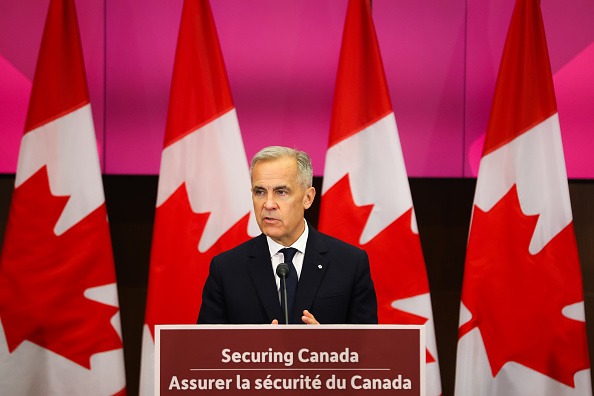
Canadian Prime Minister Mark Carney speaks at a national defense spending announcement on June 9, 2025 in Toronto, Canada. (Photo by Cole Burston/Getty Images)
Economists from Canada’s major banks have been combing through the Liberals’ budget and some have expressed cautious optimism that it’s an improvement compared to recent budgets, while noting that execution will be key in delivering results.
Prime Minister Mark Carney, a former banker at Goldman Sachs and previous head of the central banks of Canada and the United Kingdom, tabled his first budget on Nov. 4 after taking office in March.
His government says the current economic headwinds stemming from U.S. protectionism require massive expenditures to help grow the economy, which comes with a $78.3 billion deficit projected for this fiscal year. The Conservatives say they’re concerned about the high level of spending and the deficit, and argue that the government needs to remove taxes such as the industrial carbon levy to stimulate the economy.
Canada’s top financial institutions had expected a high deficit and have been analyzing whether the Liberals’ planned spending and cuts will significantly alter Canada’s economic trajectory.
Carney has pledged to transform the economy with his budget to make Canada more self-sufficient and less reliant on the United States.
This includes spending $280 billion over five years on infrastructure, defence, housing, and measures to boost productivity and competitiveness.
“For a country starving for productivity growth, tax relief and a major infrastructure push are hard to dislike, although execution on the latter will matter a lot,” BMO economists Robert Kavcic and Shelly Kaushik wrote in a Nov. 4 note.
The budget contains measures such as a “Productivity Super-Deduction” to allow businesses to write off a larger share of their capital investments. Meanwhile, planned federal spending on infrastructure is projected to total $115 billion over five years.
RBC economist Josh Nye also mentioned “execution” as a key factor that will determine whether the budget can deliver on its objective to increase growth, with follow-through needed from government and the private sector.
He said measures to help industries impacted by tariffs and the funds for infrastructure, defence, and housing should be “economically stimulative,” while noting not all these will help boost productivity and produce a return on investment.
“But at the very least, a greater focus on competitiveness, and re-orientation of spending toward more productive uses sends a positive signal that the government is taking Canada’s economic challenges seriously,” Nye wrote in a Nov. 5 note.
Scotiabank economist Rebekah Young struck a similar tone, saying the budget should support economic growth as it tackles “policy and regulatory barriers that should tip the balance towards greater investment.”
Like other bank economists, Young also mentioned the risks surrounding execution of the fiscal plan and cast doubt on how transformational the budget really is.
“The government may have over-hyped ‘transformational’ as the real test will be results that will take time,” she wrote in a Nov. 4 report, noting how the budget asks Canadians to “wait for long-term payoffs while managing short-term sacrifices.”
Economists at TD Bank say tax incentives and big spending on infrastructure will encourage some firms to invest in Canada, while raising concerns on whether this will move the needle enough.
“Given ongoing trade and economic uncertainty, this budget alone may not be enough to get firms immediately off the sidelines,” wrote TD chief economist Beata Caranci and her colleagues in a Nov. 4 note.
The TD economists say the government will need to provide more clarity on how it can work with the private sector, while also addressing concerns about tax and regulatory hurdles.
“Though government is quick to note that Canada’s marginal effective tax rate on new investment leads many of our advanced trading partners, the country’s dismal investment and productivity numbers underscore the need for action here,” they said.
The American credit rating agency Fitch Ratings said on Nov. 6 that the new budget underscores the “erosion” of Canada’s finances, and that increasing debt levels could put “pressure” on the country’s current AA+ credit rating.
On the Deficit and Fiscal Sustainability
All the increased spending has an impact on the country’s bottom line, but BMO economists point out that it’s an improvement compared to the previous budgets in that there’s more expenditure meant to stimulate growth.
They said the deficit budgets projected by the Carney Liberals are more “palatable” and “economically favourable” than those from the previous Trudeau government, as they’re less the product of social spending and more from measures to boost growth.
“We’ll stop short of calling [the budget] transformational; and we’ll also stop short of pulling the fiscal alarm,” Kavcic and Kaushik said.
Such an alarm had been pulled in late September by the Parliamentary Budget Officer (PBO), who had raised concerns about fiscal sustainability amid a projected increasing debt-to-GDP ratio. This is even while the PBO projected a lower deficit at $68.5 billion for this fiscal year. “It’s not a funny fiscal outlook,” interim PBO Jason Jacques said at the time, calling the outlook “shocking.”
CIBC economists have also said higher deficits and increasing debt “shouldn’t raise alarm bells over fiscal sustainability.”
“The real challenge won’t be to finance a few years of higher deficits, but to get money out the door, and into large capital projects and housing developments, in time to lift growth while the economy struggles to adjust to US tariffs,” the economists wrote in a Nov. 4 note.
The CIBC report says that the size of the deficit compared to the country’s GDP is not a large departure from previous periods of economic weakness.
Overall, the bank’s economists predict the budget will have a modest impact on economic growth in the near term.
“While both the economy and federal borrowing needs should improve as fiscal stimulus kicks in, Canadians will have to be patient given the lags inherent in using large scale projects as a source of growth,” wrote CIBC economists Avery Shenfeld, Ali Jaffery, and Katherine Judge.
The Liberals’ budget has no plan to balance the books, but it seeks to eliminate the operational spending deficit within three years while keep running a large deficit in the category of what Ottawa deems “investments.”
Ottawa has said this provides more transparency to Canadians, whereas Conservatives have called it an “accounting trick.”
BMO economists addressed the matter in their budget review and said it’s “unclear” what will fall under the investment category. “The sense is that a number of expenditures have been labeled as such to get pushed into the capital spending category, allowing operating targets to be achieved.”
Noé Chartier is a senior reporter with the Canadian edition of The Epoch Times. Twitter: @NChartierET
